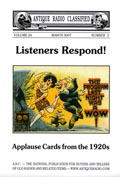Of Old Radios And Related Items--Published Monthly
VOLUME 24 MARCH 2007 NUMBER 3
EDITOR'S COMMENTS
From Antique Radio Classified for March 2007
(Copyright 1996-2007 by John V. Terrey - For personal use only.)In our zeal as collectors to concentrate on sets, hardware, prices, restoration techniques, and the like, we tend to forget about the importance of another aspect of radio history -- listening. Our lead article on applause cards by Michael Banks reminds us of the excitement folks felt in those early days about listening to their radios, the prime connection to worlds beyond their own.
These postcards offered by stations, dealers, and manufacturers gave listeners the opportunity to respond to the programs they heard. They were eager to do so; in fact, they not only bragged about picking up faraway stations, but also sometimes planned "radio parties" via the cards. In turn, the stations and manufacturers used their responses for programing and sales initiatives.
Though short-lived as a research and advertising tool, the cards tell us more about the importance of radio to ordinary lives. Unlike the more professional surveys gauging audience responses that soon replaced them, the applause cards give a personal view of the meaning of radio to early listeners.
Also short-lived in radio history were some companies formed to respond to a specific need of the times. In his ongoing research on companies of the Pacific Northwest, Art Redman has come up with the Shorty Manufacturing Company. Established by the enterprising Reid brothers, Shorty made two shortwave adapters, which allowed an ordinary broadcast receiver additionally to tune the shortwave bands. In the Depression years, these adapters were a cheaper alternative to buying expensive all-band radios.
The concept seemed a sure thing in such hard times. However, the adapters were designed for particular tube types. And, since additional tube types often came onto the market, the adapters soon became obsolete. Thus, the end of another brief success story. It was also the end of a company name, which, though perhaps intended to mean "shortwave," ironically, came to mean "short life."
Even seemingly modest success stories may have surprise, even shocking endings. Both Steve Auyer and Tom Pamula tell stories of sets that appeared to be functioning well enough with no major calamities in sight. Both were stunned by unforeseen events and offer their experiences as food for thought to us all.
Of course, we have reported on other kinds of disasters and their effects on the radio-collecting community. Examples are the California earthquake, 9/11, and Katrina. Steve and Tom report on disasters in their own homes. Steve's overheated capacitor resulted in an explosion that even broke the vacuum tube, while Tom's incorrect pilot lamps destroyed the dial face and caused a potentially serious fire.
Usually, our restoration articles offer practical step-by-step procedures and are far less dramatic than Steve's and Tom's experiences. But, they offer another side of the story -- the potential pitfalls that lurk behind any restoration effort. We're grateful to them for alerting us to situations that could happen to any of us.
Marvin Hess presents a more pleasant surprise ending in his story of an estate sale acquisition. What he thought was a tube portable radio, as the tube diagram label shows, turned out to have transistors professionally installed in a new chassis. The set is the kind of puzzlement that collectors love to decipher, and Marvin would welcome responses from fellow collectors.
Ray Chase reports on another successful Estes Auction. The Fred Bright collection totalled more than $100,000, including many items over $1,000 each. An unusual Echophone 3-tube set went for $2,700, while an Atwater Kent neon sign in excellent condition was a highlight at $4,300. Ham, paper, and other advertising items also made a good showing.
Ray makes an interesting point about the need to remember the old adage "One man's trash is another man's treasure." Richard Estes salvaged some items which had been considered not salable and destined for the trash. They added a few thousand dollars to the auction total.
A.R.C. Benefits. Be sure to take advantage of A.R.C. benefits: a toll-free number (866) 371-0512; Discover, MasterCard, American Express, Visa accepted; the Web, www.antiqueradio.com; books shipped free in the U. S. by USPS media mail; and for current subscribers, a 10 percent discount on all book orders
Coming Radio Events. Before you read this, the GBARC meet, Radio XXXVIII, in Westford, Mass., which is run by A.R.C. staff, will have taken place on February 18. But at this point, we are in high preparation mode, over 100 exhibitor tables have been sold, and we anticipate a great day. We hope more of you will plan to join us next year. Events listed for March total 10 meets, 25 meetings, and 7 auctions. Be sure to attend at least one of these in your area.
Happy Collecting!
John V. Terrey, Editor
ON THE COVEROur cover is an "Applause Card" from the John V. Terrey collection. This one illustrates a cartoonist's take on the "exaggerated exuberance" a listener might have expressed after listening to a particular program. Such a card returned to a station or manufacturer was a source of information for programming or sales targets. The words coming out of the horn are "Oh, th' Charleston" and "Honk." "Series 614 -- Radio Comics -- 10 Designs." is printed on the back side of the card.
| [Free Sample] [Books, etc., For Sale] [Subscribe to A.R.C./Renew] [Classified Ads] [Auction Prices] [Event Calendar] [Links] [Home] [Issue Archives] [Book Reviews] [Subscription Information] [A.R.C. FAQ] URL = http://www.antiqueradio.com/edcom03-07.html Copyright © 1996-2007 by John V. Terrey - For personal use only. Last revised: February 28, 2007. For Customer Assistance please contact ARC@antiqueradio.com or call (866) 371-0512 Pages designed/maintained by Wayward Fluffy Publications
Antique Radio Classified |
